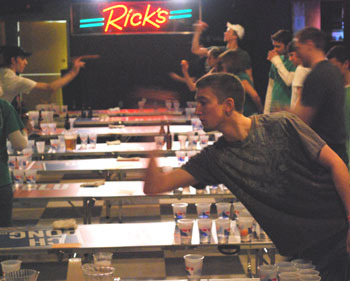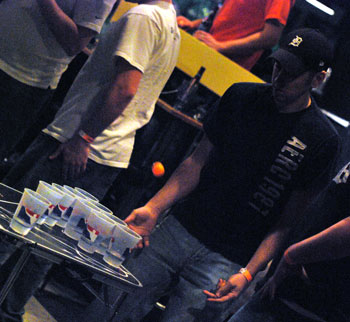Beer Pong Minus Beer: Still Beer Pong

Joe Eastman's hand almost disappears into a blur in executing the toss of a ping pong ball towards a cup. Eastman and his teammate Dane Ellis won the tournament.
“If a ball bounces off a dead cup into a live one, does that count?” was the question to Drew Harrison from a competitor in Saturday night’s double-elimination beer pong tournament held at Rick’s American Cafe on Church Street.
Harrison is operations manager of Clutch Pong, a company that’s trying “to bring this game out of people’s backyards, basements, and porches and turn it into a mainstream sport giving everyone a chance to play.” Contestants paid $20 apiece ($40 per team) for a shot at the first place prize, which was tickets and a hotel stay in Atlantic City from June 11-13.
When Ann Arbor residents see beer pong in the wild, it’s typically on front lawns in the campus district, and is very much linked to the first word in the name of the game. Part of the effort to grow the activity from a drinking game to a sport – and to comply with Michigan Liquor Control Commission requirements – is taking the beer out of beer pong. Harrison explained that it’s not about the rule against having alcohol involved in a game of chance – beer pong is a game of skill. The MLCC’s concern is about games with rules that compel, or even encourage, the consumption of alcohol.
Where and Why Is the Beer?
To see how beer pong – when played with beer in the target cups – could compel or encourage the consumption of alcohol, it’s worth laying out the basic structure of the game’s concept. What, for example, is a target cup?
A game begins with two-person teams standing at opposite ends of a table. On each end are arranged 10 plastic cups in a “right triangle formation” pointing towards the other team. Teams alternate trying to toss a ping pong ball into one of the cups on the other team’s end. If a toss is successful, the cup in which the ball has landed is removed from play. The first team to eliminate all the cups on the other team’s end wins the game. Players cannot “defend” the cups on their own end by “goal” tending, but after a ball has hit any cup’s rim, they’re allowed to swat it away.

We believe we've correctly identified this player with the excellent follow-through as Lester Marks.
The beer in beer pong goes into the target cups. If there’s beer in the target cups, then the removal of a cup from play after a successful toss includes consumption of the beer in that cup by the team on that end. Whether that consumption is required depends on the rules.
It would be straightforward to eliminate any rule that requires consumption of the beer in an eliminated cup. However, from the MLCC’s point of view, if there’s beer in those cups, the possible informal expectation that the beer would be drunk, nothwithstanding any rules, amounts to an encouragement to drink.
So at Rick’s on Sunday night, there was no beer in the target cups. Water was substituted, and there was no rule requiring consumption of the water.
Why have any liquid at all? Filling the cups about 1/3 of the way with some liquid provides the necessary anchoring weight in order to keep the cups upright under repeated assault by ping pong balls.
Because there’s no drinking at all – of water or beer – the Clutch Pong rules eliminate another common concern about the game, which is the spread of germs through the ball, which lands in the beverage.
Technique of the Toss
We chatted briefly with some of the players about their shooting technique, among them, Dane Ellis and Joe Eastman, who placed fourth in the World Series of Beer Pong held in Las Vegas in January. (Another competitor offered the name Kinz, but on review of our notes, we can’t say definitively if that was the name of his team or his own name.)

The toss was not as errant as it might appear. The ball bounced off one of the cups. Note that the leftmost cup in the picture has been removed from play. It was previously in the second row of the "rack" of cups.
What we’d observed exclusively in warm-ups and the tournament’s first round was basically an overhand arching shot, with a motion that’s similar to dart throwing. Not being a dart thrower, Ellis said that he didn’t see any transference from that sport, but said that he thought his background in basketball was a help. There was a consensus that one key was the ability to focus on the cup. No one had seen the use of an underhanded shot, and especially not a two-handed version. However, they did describe the possibility of a bounce shot – deliberately bouncing a ball off the table into a cup – but it did not seem to be common.
Clutch Pong
Drew Harrison is joined in the enterprise of Clutch Pong by some buddies who were inspired by their attendance at the third World Series of Beer Pong. In addition to Harrison, the Clutch Pong “family” includes Josh Miller, Paul Adamission, and Tim Mentink. Mentink’s mom, Jan Tripp, was also on hand at Rick’s on Saturday night, wearing a Clutch Pong staff shirt and lending her support.
Sunday’s event at Rick’s is a part of a series of beer pong tournaments hosted by Clutch Pong – there’s a regular competition in Jackson. There’ll be another tournament in Ann Arbor, also at Rick’s American Cafe, on April 18.
If The Chronicle attends that event, it will not be to cover it as a feature story, but as a couple’s night out – and the Chronicle’s publisher would enjoy the benefit of free tournament entry, based on the Clutch Pong policy of: “Ladies = Free.”
And if we participate, we’ll be up to speed on the rule question posed at the beginning of this article. The answer: “No, ‘slop’ doesn’t count.”







Damn right his name is Kinz! CLETROIT!
We (Dane Ellis and Joe Eastman) mentioned in the article are also running tournaments throughout the mid-Michigan area. You can see our tour schedule at http://www.michpong.com. Come on out and join us for a night of beerpong and a chance to win entry into the Worldpongtour.com tournament of champions for $25,000!
Great article! I think it’s important to show people the positive side of beerpong as you did. It’s really about the competition not the drinking, and I think you pointed that out well.
And Kinz, I can’t believe you actually got a mention haha. I mean we know that’s the only way your gonna get a mention in an article lol.
And Dane must have told him that no article is complete without a photo of himself. Cause I’ve never heard that before in my life!
Love the artistic use of blur and somewhat fuzzy images. That’s exactly how I remember the game from back in the “good old days”.